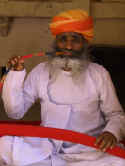Photo
Highlights: Part 1
Part 2
Part 3
Part 4 Back
to Home Page
Namaste
from Nepal! India Report: July 4, 2002
|
DISCLAIMER!!!:
India culture, traditions, and logic is extremely foreign to the western
world, so it is very difficult to accurately describe our personal, biased
experiences without really pissing off our Indian friends.
Hopefully they can see the humor, and irony through our eyes and not take
offense to this. God knows that I
piss off enough people in America; I don’t need any more enemies.
I’ve finally cooled off from the
Indian heat of 115 degrees F (46 Centigrade) and my brain has mellowed out from
the sensation overload to give my report on India.
We spent almost 3 months in the Indian Subcontinent, and it has been the
most bizarre, fascinating, colorful, beautiful, ugly, dirty, and friendly place
on the world tour to date.
It’s been very difficult for us to
write about India while we were traveling in the country because every day there
is a completely wacky happening, sensory overload, or religious curiosity that
would boggle our heat-fried minds. We
came to India really without any expectations except to see the wildest and
wackiest culture possible (while not on mind altering drugs).
Well, we got it and more. The
circus was in town and we got the full 3-ring show.
|
|
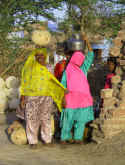 The culture:
Rural India remains much the same as it has been for thousands of years.
Even in the modern cities such as Delhi, Calcutta, or Bombay, what
appears to be a complete swing of attitude and lifestyle is largely surface gloss.
The modern state itself is a relatively recent creation born out of a
people’s zeal to throw off the yoke of colonialism. Underneath, the age-old verities, loyalties and
obligations still flourish. Possibly
no other county has its religions so intertwined with every aspect of life.
The culture:
Rural India remains much the same as it has been for thousands of years.
Even in the modern cities such as Delhi, Calcutta, or Bombay, what
appears to be a complete swing of attitude and lifestyle is largely surface gloss.
The modern state itself is a relatively recent creation born out of a
people’s zeal to throw off the yoke of colonialism. Underneath, the age-old verities, loyalties and
obligations still flourish. Possibly
no other county has its religions so intertwined with every aspect of life.
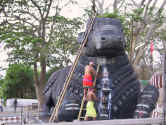 To quote Lonely Planet,
““Indian logic” can often see bizarre, convoluted and even
exasperating. Yet it encompasses a
unique cosmology that is a holistic and coherent as well as fascinating”.
India was the birthplace of two of the world’s great religions
(Hinduism and Buddhism) and one of its smallest (Jainism).
India has remained the world’s largest democracy for over 50 years
(population over 1 billion now). It
has also been revered as the most corrupt government on the planet.
To quote Lonely Planet,
““Indian logic” can often see bizarre, convoluted and even
exasperating. Yet it encompasses a
unique cosmology that is a holistic and coherent as well as fascinating”.
India was the birthplace of two of the world’s great religions
(Hinduism and Buddhism) and one of its smallest (Jainism).
India has remained the world’s largest democracy for over 50 years
(population over 1 billion now). It
has also been revered as the most corrupt government on the planet.
A great example of the diversity of
culture is that in some sections of the country it is against the religion and
law to eat eggs, but at the same time, the same people drink liquefied opium on
a daily basis! Downtown Delhi is
hard to get a glass of beer, but anyone can get heroine from any street corner.
So here it is:
The people:
We were completely taken back by how incredibly outwardly friendly the
Indian people are. Part of
being Caucasian in their country makes us a real novelty (suddenly we were on
display), but the Indian culture is really based on hospitability and
friendliness. A large part of
our experience was being hosted by a local family in Bombay, our first
destination from our arrival from Africa. We
hooked up with them via a hosting website called:
http://www.globalfreeloaders.com
The Bubber family arranged for a nice (and inexpensive) hotel near their home so
we could socialize with them. What
we thought would be a couple days in Bombay, and perhaps a nice dinner with them
turned out to be 10 days of being wined and dined at their home, country club,
cricket club, country home, taken to birthday parties, and friend’s homes
until we gained too many pounds (kilos) to stay any longer. It was a great way to get to know a certain
socio-economic class of India. They
were also great to fill us in on the nuances of the various Indian cultures and
religions.
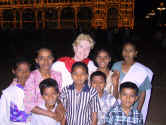 Wherever we went, especially where
there were Indian tourists at a sight, we became big celebrities. Especially Julia, who had her Marilyn Monroe blond hair due,
plus the fact that she was wearing Indian clothing made her a big attraction.
Most countries we have traveled to, if we wanted a photo of someone, we
would need to ask them and either pay them money or schmooze up to them (though
we have plenty of “spy camera shots” on people.
In India, everywhere we would go, the Indians would run over to take a
photo with us and sometimes would hand us their baby so they could take a photo
of “there western friends” with their baby.
I wonder how many coffee tables have a photo of us displayed in a nice
frame.
Wherever we went, especially where
there were Indian tourists at a sight, we became big celebrities. Especially Julia, who had her Marilyn Monroe blond hair due,
plus the fact that she was wearing Indian clothing made her a big attraction.
Most countries we have traveled to, if we wanted a photo of someone, we
would need to ask them and either pay them money or schmooze up to them (though
we have plenty of “spy camera shots” on people.
In India, everywhere we would go, the Indians would run over to take a
photo with us and sometimes would hand us their baby so they could take a photo
of “there western friends” with their baby.
I wonder how many coffee tables have a photo of us displayed in a nice
frame.
On many occasions, while out at a
local restaurant trying to avoid the meat and extra spicy dishes (the love
chilly peppers in India, a.k.a. curie), people would just walk over and stare at us
eating, kinds of the way people stare at a TV.
The staring glazes seem to be a national phenomenon with men in India.
At least several times a day, men would be in a glazing trance eyeballing
Julia, sometimes only 5 feet away. (the
personal space in India is about 1 foot).
There seems to be very little chance of any physical confrontation to
western women from Indian men, but most of the time, they need to be “shooed
away”. I think it’s their
curiosity of seeing someone quite different that puts them in a trance like
stare. It makes me wonder how often
we are really staring at these very interesting looking people.
(by the way, India makes a superb country for photographing the unique
and strange people and outfits, see attached photos).
It’s always a bit difficult to
really get to know people of a country, but we traveled many days on the trains,
which provides a great backdrop to talk with people 1 on 1.
The people we spoke to on the trains were usually very well educated and
their mannerisms and way of interacting with us were closer to those of the
west, so we were as distracted (or annoyed) as when we would try to talk to a
shop owner or “man on the street”.
Frustrations:
Besides being in India when the heat wave was crashing on us, which could
fry your brain, we eventually became the most frustrated with the daily
interactions of people in India. (partly
because we spent so much time there that the same things just seem to accumulate
in the annoyance department). The Indian culture is one that always wants to please
someone when asked, but will never say “I don’t know” when asked a
question. We could be sent on wild
goose chases looking for something because someone would make up an answer or
direction to accommodate us.
Another thing is when asking for a
yes or no answer (usually to confirm a price haggling for), the person would
never-ever say the words yes or no, they would nod their head.
Now if they did the western up and down for yes, side to side for no, it
would be clear, but noooo, they wobble their head side to side in a circular
motion for both yes and no (I’m sure there is some distinction between the
two, but we can’t see it). It
looks like the little head bobbing dogs that people put on the dash board of
their car.)
|
Tourist Touts:
A tout is someone who is trying to get you into their shop, take you to
their cousin-brother-uncle’s carpet/pottery store. These guys will hound you as you walk by their store on the
street. Hundreds of these guys a
day telling you that “looking is free” will about make you blow a gasket.
Anytime that we would need to buy anything, or especially when booking an
auto rickshaw, about a dozen guys come over to listen to the discussion, and if
they were other drivers, do a bit of conspiring on the price.
It seems that everything is always everyone’s business and many times
we would tell people to scram. One
time, Julia started to sing and dance because they would just stand there and
stare at us. (can you start to see
the point on things really building up over time)
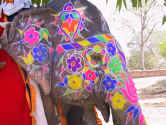 Festivals:
With 330 million deities, there is probably a festival somewhere in India
every day of the year. The Indians
love to throw a party, parade, bask a stone idol in milk, and bang some drums.
A great time we had was the Elephant festival of
Jaipur, which is in the
colorful state of Rajasthan (in the northwest). Festivals:
With 330 million deities, there is probably a festival somewhere in India
every day of the year. The Indians
love to throw a party, parade, bask a stone idol in milk, and bang some drums.
A great time we had was the Elephant festival of
Jaipur, which is in the
colorful state of Rajasthan (in the northwest).
Up in the northern region of the
country we visited the mouth of the Ganges River (which is the holiest river in
India) where nightly there would be thousands of pilgrims to bathe in the river
while chanting and singing. Torches
lit, floating leaves with candles would float down the river to illuminate the
evening. Gurus dressed in orange
sheets and deadlocked hair hanging to their waste would bless us.
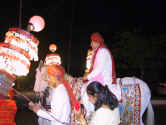 Wedding:
About 6 weeks later we got an email from the Bubber family to invite us
to Delhi to attend their cousin’s wedding.
Indian’s love to throw a party and a wedding is the end all of parties.
4 nights of celebration over 5 days.
Day 1 is the engagement party (the 3rd meeting of the bride
and groom as this is an arranged marriage).
There is some religious gurus there and the groom gives the bride a huge
gold necklace (to match the 3 or 4 pounds of gold
Day 2 is a music night and the women all get their hands painted with
henna. Day 3 is the ceremony where
the groom rides down the street on a white horse with a big procession of
marching band (picture your high school’s band, but now 30 years old). Wedding:
About 6 weeks later we got an email from the Bubber family to invite us
to Delhi to attend their cousin’s wedding.
Indian’s love to throw a party and a wedding is the end all of parties.
4 nights of celebration over 5 days.
Day 1 is the engagement party (the 3rd meeting of the bride
and groom as this is an arranged marriage).
There is some religious gurus there and the groom gives the bride a huge
gold necklace (to match the 3 or 4 pounds of gold
Day 2 is a music night and the women all get their hands painted with
henna. Day 3 is the ceremony where
the groom rides down the street on a white horse with a big procession of
marching band (picture your high school’s band, but now 30 years old).
 This goes for nearly 90 minutes with dancing by the groom’s friends.
At the gate of the country club, the male members of each side of the
wedding meet each other and the bride’s family would hand over a wad of cash
to the male counterpart of the groom’s family.
Besides this small payout, the bride’s family hand over a HUGE dowry. (Often tens of thousands of US dollars worth). The
party at the ceremony is quite a lavish affair with dozens of waiters with
platters of food and drink. The party starts about 9 pm and runs until the
ceremony starts early the next morning. With the temperature at 95 degrees
F (33 C), it's good it's that late. The
marriage ceremony actually starts about 2 am that night, when the stars are in
alignment according to the astrologers forecast. Day 4 is a day off to
rest and consummate the marriage. Day 5 is the reception. This goes for nearly 90 minutes with dancing by the groom’s friends.
At the gate of the country club, the male members of each side of the
wedding meet each other and the bride’s family would hand over a wad of cash
to the male counterpart of the groom’s family.
Besides this small payout, the bride’s family hand over a HUGE dowry. (Often tens of thousands of US dollars worth). The
party at the ceremony is quite a lavish affair with dozens of waiters with
platters of food and drink. The party starts about 9 pm and runs until the
ceremony starts early the next morning. With the temperature at 95 degrees
F (33 C), it's good it's that late. The
marriage ceremony actually starts about 2 am that night, when the stars are in
alignment according to the astrologers forecast. Day 4 is a day off to
rest and consummate the marriage. Day 5 is the reception.
|
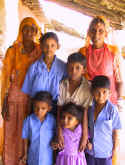 Many (probably most) weddings in
India are still arranged, usually by the time the woman is 24 in the cities, and
perhaps 16 in the country. One
family we met way out in the country has the 12 year old daughter to be married
this summer. (see country
family pose, the girl in the middle in the blue shirt is the one).
For those professionals who haven’t wed by their mid 20’s or so, the
newspapers have pages of ads to arrange a marriage. Quite different from the dating section in the US papers,
these people cut right to the chase, usually proclaiming that they make a big
income, 1st born male (gets the inheritance and family business),
went to the top university, and is light skinned. A
great movie to see this event is "Monsoon Wedding".
Many (probably most) weddings in
India are still arranged, usually by the time the woman is 24 in the cities, and
perhaps 16 in the country. One
family we met way out in the country has the 12 year old daughter to be married
this summer. (see country
family pose, the girl in the middle in the blue shirt is the one).
For those professionals who haven’t wed by their mid 20’s or so, the
newspapers have pages of ads to arrange a marriage. Quite different from the dating section in the US papers,
these people cut right to the chase, usually proclaiming that they make a big
income, 1st born male (gets the inheritance and family business),
went to the top university, and is light skinned. A
great movie to see this event is "Monsoon Wedding".
Now the weird stuff:
We have yet to be completely baffled by
a country’s people from what can only be described as an alternative logic.
With the religious differences in abundance (over 10,000 different gods),
it’s hard to know what’s going to happen day to day.
I can actually write at least 100 different antidotes but I’ll spare
you for now. Many to come on the
website. With over 1 billion
people, many illiterate and living in a world completely wrapped up in
superstitions (not that every religion seems superstitious to outsiders), there are as many
different ways of thinking and living as there are people.
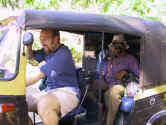 Weird # 1:
Our auto rickshaw driver we hired for the day had us cruising down a hill
just as it was getting dark, all of a sudden; we swerve and then pull over to
the side to stop (actually sitting halfway in the middle of the road just in
case a truck would like to plow into us for fun). The driver gets out and looks back down the road a bit, then
crosses his legs, squats down and prays while standing in the middle of the
road. We are just a bit puzzled by
this and wait a minute or so until he get back in.
He tells us that he is extremely sorry that he ran over that snake on the
road, who by the way, is his god. Now
that’s a bad day for someone, killing your god.
Weird # 1:
Our auto rickshaw driver we hired for the day had us cruising down a hill
just as it was getting dark, all of a sudden; we swerve and then pull over to
the side to stop (actually sitting halfway in the middle of the road just in
case a truck would like to plow into us for fun). The driver gets out and looks back down the road a bit, then
crosses his legs, squats down and prays while standing in the middle of the
road. We are just a bit puzzled by
this and wait a minute or so until he get back in.
He tells us that he is extremely sorry that he ran over that snake on the
road, who by the way, is his god. Now
that’s a bad day for someone, killing your god.
Weird # 2:
This is a dandy from our friends Devin and Jenny who met up with us in
Delhi. When they were trying to
catch a flight out of Delhi (to avoid any nuclear warheads that might be coming
their way from Pakistan at the time) the arranged for a cab to pick them up in
the morning. Of course the cab
wasn’t arranged, so as usual waited another ½ hour to get someone’s
brother’s cousin to get over to the hotel.
Now running a bit late to start, they hopped in the cab and started to
the airport. Five minutes later the
driver pulls over to pick up some chapattis (round bread thing).
Ok, he’s back in the car, let’s get going. A few minutes later down the road, the driver decides to pull
over again, get out of the car and walk over to a tree full of monkeys, where he
proceeds to start hand feeding the monkey each a chapatti.
He also won’t go to the next monkey until that monkey takes the
chapatti. Well after 5 minutes of
watching this in shock, Devin convinces the driver to just leave the chapattis
and start driving again. Finally at
the airport the driver says (of course): “Tip
for the driver?” With Devin’s
reply: “Don’t feed the
monkey’s on the way to the airport”.
Weird # 3:
Again from Jenny and Devin. While
at a nice zoo in Mysore city (in the south), they came to the cage of a tiger
with a baby cub. The bars are only
a few feet away from where people can stand. An Indian man decides that he would like to provoke the tiger
to move or roar, so he picks up his infant child and starts dangling the baby
right up to the bars of the cage to antagonize the tiger.
After 3 months in India, this sounds a bit shocking, but not surprising
in the least.
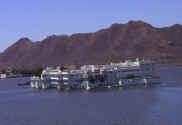 The sights: Whatever
preconception I had of India disappeared the more I traveled.
The land is as varied as could be imagined.
Beautiful beaches, tropical rainforests, dessert cities, 8000 meter snow
capped peaks, it has it all. With a
history of 5,000 years, there are temples at almost every turn.
India is as vast as it is crowded and as sublime as it is squalid.
The plains are as flat and featureless as the Himalayas are towering and
spectacular.
The sights: Whatever
preconception I had of India disappeared the more I traveled.
The land is as varied as could be imagined.
Beautiful beaches, tropical rainforests, dessert cities, 8000 meter snow
capped peaks, it has it all. With a
history of 5,000 years, there are temples at almost every turn.
India is as vast as it is crowded and as sublime as it is squalid.
The plains are as flat and featureless as the Himalayas are towering and
spectacular.
Every state has a palace and usually
a fort, some nearly 1,000 years old, others built during the British occupation
early in the 20th century. Some
are an ancient mystic fortress and pageantry that hosted hundreds of elephants
in the courtyard, others look like they came right out of England. (the one in Udaipur is a “floating” palace on a lake.
This palace and city were the setting for the James Bond movie “Octopussy”)
 Cows:
Cows, cows, and more cows.
Cows:
Cows, cows, and more cows. 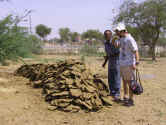 They
are everywhere. Every side street,
major intersection, up the side of a mountain cliff, some walking in the front
door of someone’s home. These big
dog faced mellow creatures rule the country.
Thousands of cars zooming by a cow in the middle of the street does not
faze them one bit. The problem is
that a billion or so cows leave a lot of cow doo doo around which can be a bit
much especially when the temperature goes up and starts to cook it.
Amazingly, many cities have someone (low man on the caste totem pole)
that scoops up the paddies from the walking places.
We’ve seen nice pancake looking stacks at least 10 feet tall and 30
feet wide (like a pyramid), probably to use as burning fuel later.
They
are everywhere. Every side street,
major intersection, up the side of a mountain cliff, some walking in the front
door of someone’s home. These big
dog faced mellow creatures rule the country.
Thousands of cars zooming by a cow in the middle of the street does not
faze them one bit. The problem is
that a billion or so cows leave a lot of cow doo doo around which can be a bit
much especially when the temperature goes up and starts to cook it.
Amazingly, many cities have someone (low man on the caste totem pole)
that scoops up the paddies from the walking places.
We’ve seen nice pancake looking stacks at least 10 feet tall and 30
feet wide (like a pyramid), probably to use as burning fuel later.
 Religion:
Religion is engrained into every aspect of the Indian culture.
Despite the current mass murders between the Hindi’s and Muslims over
the 500 year old religious sites, the Hindi culture is one of peace and
kindness. Living a righteous life
will bring good karma to your next life.
Religion:
Religion is engrained into every aspect of the Indian culture.
Despite the current mass murders between the Hindi’s and Muslims over
the 500 year old religious sites, the Hindi culture is one of peace and
kindness. Living a righteous life
will bring good karma to your next life. 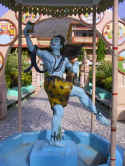 A
pretty good concept in itself. Hinduism
is still a nut that I haven’t really cracked, as the outward idol worshiping,
animal deities, and oppression of people in castes and woman have made it a bit
difficult for me. I still haven’t
figured out why people worship a cow because it gives milk (the milk of life)
but will allow a woman to be burned by her husband if he’s pissed off at her
or her dowry isn’t enough for him. I
would think that a woman should be revered, as they are the ones that are
nursing the children, if that logic hold true.
Religion and logic don’t always go hand in hand, so I’m still working
on the figuring out the real core goodness of Hinduism, and not just the
aberrations that seem to happen in most religions.
A
pretty good concept in itself. Hinduism
is still a nut that I haven’t really cracked, as the outward idol worshiping,
animal deities, and oppression of people in castes and woman have made it a bit
difficult for me. I still haven’t
figured out why people worship a cow because it gives milk (the milk of life)
but will allow a woman to be burned by her husband if he’s pissed off at her
or her dowry isn’t enough for him. I
would think that a woman should be revered, as they are the ones that are
nursing the children, if that logic hold true.
Religion and logic don’t always go hand in hand, so I’m still working
on the figuring out the real core goodness of Hinduism, and not just the
aberrations that seem to happen in most religions.
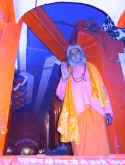 Some of the really bizarre sights were not the ancient stone temples, but
the modern Disney like statues and religious theme parks (see photos), it really
became a goofy extreme of idol worship when the god is all blue and looks like
looks like an action figure or Ganesh the elephant looking god looks more like
Dumbo. The funny thing is I
can see how many religions seem very strange from the outside when the
ceremonial aspects and customs is mostly what you see on a day to day basis. It makes me wonder about all of the Christian (especially
Catholic) ceremonial practices just seem as bizarre. Actually, one of my Muslim friends attended a Catholic wedding with
me in the US and seemed amazed at all of the elaborate rituals, costumes, and
ornation surrounding a ceremony. The more different I see people, the more of the similarities
I see in everyone. It’s really
becoming quite the cosmic joke.
Some of the really bizarre sights were not the ancient stone temples, but
the modern Disney like statues and religious theme parks (see photos), it really
became a goofy extreme of idol worship when the god is all blue and looks like
looks like an action figure or Ganesh the elephant looking god looks more like
Dumbo. The funny thing is I
can see how many religions seem very strange from the outside when the
ceremonial aspects and customs is mostly what you see on a day to day basis. It makes me wonder about all of the Christian (especially
Catholic) ceremonial practices just seem as bizarre. Actually, one of my Muslim friends attended a Catholic wedding with
me in the US and seemed amazed at all of the elaborate rituals, costumes, and
ornation surrounding a ceremony. The more different I see people, the more of the similarities
I see in everyone. It’s really
becoming quite the cosmic joke.
Poverty and begging:
The poverty of India is one of the world in the world, partly because a
billion people makes it difficult to get out of the cycle of rural living
without the benefit of an education. The
caste system still holds people down, the government does not require children
to attend school, and without the economy built up to get tax revenue from, the
people who are poor will as in most countries remain that way for countless
generations. Again, looking at the US, many non Americans have commented
on how struck they were on all of the homeless people in the big cities
when they traveled in America.
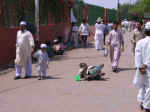 What I was faced with more so than
other countries was the amount of people begging.
It is not uncommon for parents to mutilate their children in order to get
more money from tourists. It’s
very difficult to see little children 2 or 3 years old walking around busy
streets with their hands out, pointing to their mouths.
I have 2 nieces that age and can’t help feeling overwhelmed with sorrow
and feel the need to do something for them.
Here’s the problem: Many
of the children in India on the streets have been either sold by their parents
or kidnapped by an adult who puts these kids out on the streets to beg, the gets
the money. Kids are also asking for
you to purchase some milk for them (the largest one) then when you leave, sell
it back and get a good profit. There
are plenty of hungry people in India, but it gets to the point that you feel
that everyone is scamming you. Women
holding a baby in their arms are walking around the tourist areas looking so sad
and hungry, ask for money for their baby, but later you see them laughing at the
big money they got from someone else. Most
people who live in the US and work in a big city see beggars on the street, and
I usually give them a buck or two, but I don’t feel that they scammed me, nor
that they were prostituting their children.
Occasionally I would see an old lady just sitting by the side of a
building with a cup and give her money. The
old women usually have been widowed and have no means of support.
The real problem I faced was becoming immune to people pawing at me for
money and not even seeing the poverty after a while.
I don’t want to become desensitized, but there are things we must do to
keep our sanity and keep a focus on just making it across town without being run
over by a camel or hit by an auto rickshaw.
That’s the reality of 3rd world travel, dealing with the
fact that you need to ignore suffering just to get thru the day sometime. What is suggested is to just make a donation to a charity to
do something, and somewhat clear one’s conscious.
What I was faced with more so than
other countries was the amount of people begging.
It is not uncommon for parents to mutilate their children in order to get
more money from tourists. It’s
very difficult to see little children 2 or 3 years old walking around busy
streets with their hands out, pointing to their mouths.
I have 2 nieces that age and can’t help feeling overwhelmed with sorrow
and feel the need to do something for them.
Here’s the problem: Many
of the children in India on the streets have been either sold by their parents
or kidnapped by an adult who puts these kids out on the streets to beg, the gets
the money. Kids are also asking for
you to purchase some milk for them (the largest one) then when you leave, sell
it back and get a good profit. There
are plenty of hungry people in India, but it gets to the point that you feel
that everyone is scamming you. Women
holding a baby in their arms are walking around the tourist areas looking so sad
and hungry, ask for money for their baby, but later you see them laughing at the
big money they got from someone else. Most
people who live in the US and work in a big city see beggars on the street, and
I usually give them a buck or two, but I don’t feel that they scammed me, nor
that they were prostituting their children.
Occasionally I would see an old lady just sitting by the side of a
building with a cup and give her money. The
old women usually have been widowed and have no means of support.
The real problem I faced was becoming immune to people pawing at me for
money and not even seeing the poverty after a while.
I don’t want to become desensitized, but there are things we must do to
keep our sanity and keep a focus on just making it across town without being run
over by a camel or hit by an auto rickshaw.
That’s the reality of 3rd world travel, dealing with the
fact that you need to ignore suffering just to get thru the day sometime. What is suggested is to just make a donation to a charity to
do something, and somewhat clear one’s conscious.
In a nutshell, India is a place that
if you stay long enough, the cliché seems to hold true, “you will both love
it and hate it”. I loved it much more
than I hated it, and most of the angst was due to the stress of being there in a
110 plus heat for almost 2 of the 3 months.
I think the phrase that truly sums it up is: "It ‘s a place that’s difficult to travel in, but equally difficult to
leave." Will I return to India
one day? Absolutely!
as an extra perspective, here is an email from our friends experience in
India...
We wanted to mention a few last things about our last week in India. First
of all, Kathmandu has literally been a breath of fresh air coming from Delhi.
In fact, I would liken Delhi to the nastiest, smelliest, most unkept armpit on
earth. Although we feel that we are somewhat immune to much of the filth
we encounter at this point, the Lonely Planet Recommended Hotel where we were
staying had foul 24-hour occupied open-air urinals conveniently located right
outside our hotel door. Fly infested cow patties and chicken feces lay
mixed with rubbish and rotting food on the streets while the diesel rickshaws,
people and animals walked right on through it! There are people
everywhere, and we mean everywhere! The stench and the assault of the
crowding was unbearable in the upwards of 115 degree heat. It was quite a
shock to our senses after having such a great experience in Kerela. Our
only refuge in Delhi was meeting up with one of our friends there on business
who took us out to a excellent dinner in an air-conditioned fine restaurant.
It was an incredible luxury to be in a serene, plush environment with a trusted
friend and it meant a great deal to us!
As a final note on our experiences in India, we happened to meet 2 American
medical students who were doing an internship at one of the more
"modern" hospitals in Southern India. Their were no lights in
the hallways and "No Spitting" signs were everywhere. We decided
to delay our journey to Delhi to see more of the hospital and talk to the
Americans about their experiences.
Throughout India we had seen extreme poverty and starvation even on the
nicest city streets. You see things that are hard to imagine in America
like extreme cases of grotesque elephantitus, polio and leprosy victims banished
from their own communities. Sadly, people are dying everyday of curable or
treatable diseases like tuberculosis. At the hospital they had an entire
ward dedicated to tuberculosis and an outpatient clinic for polio and leprosy
victims...by the way, it is hoped that polio and leprosy will both be completely
irradiated from the earth within 5 years. The hospital had one needle it
used for AIDS patients and one for non-AIDS patients. There was no money
for such extravagances as ventilation machines to help people who can't breathe
on their own, so family members take turns sitting by the bedside to hand pump
air into the lungs of their loved ones 24 hours a day for as long as it is
needed. Remember, this is one of the "modern" hospitals!
One of the hospitals patients that the students told us about gave us a very
different impression of some of the incredibly difficult situations that Indian
women are subject to. The patient was a woman with 3rd degree burns on
over 50% of her body....she had been the victim of a "Dowry Burning."
In short, it is common for most women and men to marry through parental and
horoscope compatible arrangements. It is customary for the brides parents
to pay the groom an average of 50,000 rupees and a pre-set amount of gold as a
dowry. It occasionally happens that the groom becomes discontent (for any
reason) with his new wife (or gets greedy when the dowry runs dry) and demands
more money from the brides parents to ensure ongoing marital bliss. If her
parents don't pay, he simply douses his wife with kerosene and sets her on fire.
It is rare that the wife lives, or that the husband is prosecuted since there
are no witnesses (and as we read in one newspaper article, "surely the
woman must have done something to provoke such an act.") The husband is
then free to remarry and receive a new dowry. After her story was brought
to our attention, we noticed several "incidents of suspected dowry
burning" in the news everyday.
....and we thought America has issues!
Bruce and Julia, World Travelers and
Adventure Seekers Extraordinaire.
Copyright © 2002 by [MyWorldTour.org]. All rights reserved.
Revised: 05 Feb 2007 20:21:26 -0600
.
![]()
